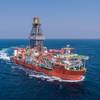RIB Report
World Record Atlantic Crossing Succeeds in RIB
The first ever unassisted crossing of the North Atlantic just south of the arctic circle in a small, open, Rigid Inflatable Boat (RIB) has been completed by a team of dedicated adventurers led by Bear Grylls. Traveling from Nova Scotia to John O'Groats via a route which passed just south of the Arctic Circle, the expedition, which has raised around $80,000 for the UK young persons' charity, The Prince's Trust, has been completed a week ahead of schedule despite encountering icebergs and horrendous weather conditions.
The expedition, which involved a five-man team sailing the open boat across 3,000 miles of the North Atlantic on a route that saw landfall in Halifax, Nova Scotia, Mary's Harbor in Labrador, Nanortalik, Greenland, Reykjavik, Iceland, the Faroe Islands and finally Scotland, took a total of 19 days to complete. As leader Bear Grylls explains, it was a long 19 days: "There were undoubtedly more moments of jeopardy out there in those remote icy cold seas than I had ever anticipated, and in truth, if I had any idea of how frightened all of us would be at stages, I would have thought twice before I left everything - family and safety - for those northern waters. The boat was fantastic and the Caterpillar engine didn't miss a single beat, despite the ever-changing sea conditions with waves at times 30 ft high. "The support we have had from Finning (UK) Ltd and Caterpillar has been tremendous. They have not only supplied us with a first class engine but endless and unwavering technical and moral support as well as the friendship that has been the watchword of this entire expedition." The boat achieved a top speed of 35 knots at reduced fuel and water levels and in calm sea conditions. However, on the longest leg of the voyage — from Greenland to Reykjavik — spanning a distance of over 850 nautical miles, when loaded with additional fuel and water tanks, the average speed was 12 knots in sea conditions that included running into a force 8 gale.
"We believed that the crossing was tight but possible and we have now proved it," comments Bear Grylls. "There are no cabins or bunks as such - these vessels are usually used as fast, extremely manoeuvrable people movers and the boat would usually take around 12 passengers. On the challenge boat, the passenger space was taken up with stores of fuel, water, food, navigation and medical equipment. The only covered area on board was for this equipment and the team slept on top of the engine in what can only be described as a large open sardine tin!"
Silver Ships/AMBAR Marine
Having built over 200 aluminum RHIB's, Silver Ships, Inc./AMBAR Marine, has grabbed a foothold in the design and construction of aluminum RHIB's - all of which are constructed in accordance with SOLAS regulations.
The U.S. Coast Guard operates 90 AMBAR Marine Non-Standard RHIB's and the U.S. Navy Sea Systems Command operates 40 AMBAR Marine Special Service RHIB's. Silver Ships, Inc. / AMBAR Marine constructs approximately 43 vessels per year, 80 percent of which are RHIB's while the remaining 20 percent have been Patrol/Security boats, and various work boats ranging from 23 to 48 ft. (7 to 14.6 m).
Ribcraft
Ribcraft USA introduced a technologically driven 25-ft. RIB, which integrates multiple technologies, all designed to increase driver and passenger comfort and safety, into one boat. The charge for this RIB was to take a hull with the Ribcraft 7.8 design, and start from the waterline up using completely innovative technologies to improve the overall comfort. This was accomplished by modifying the configuration to allow for longer, more comfortable offshore passages. The 7.8's proven offshore hull design features a generous deep "V", an impressive forward dead rise, and multiple full length spray rails. To compliment their in-house design team, Ribcraft tapped Dr. Johan Ullman, a world-renowned expert on back and neck injuries from high-speed performance boats, and Mark Fitzgerald of C.W. Paine Yacht Designs. Working closely with Ribcraft’s team and the client, Ullman created an ergonomically correct console, better referred to as a "cockpit."
Protector
Protector, a multipurpose, high-performance boat engineered for work and designed for response has already been customized in the U.S. for marine police patrol, search and rescue, firefighting, and other commercial operations. "Everyone who has had the opportunity to operate our new 28-ft. Port Security demonstrator appreciates Protector's deep understanding of commercial quality," says Bill Clark, Protector's director of Commercial Products. The Protector, a rigid hull inflatable boat (RIB) with a cabin, offers the safety, stability and power - even in the most challenging conditions. Introduced to the U.S. in the late 1990s, Protector already has a successful performance record with New Zealand's leaders in the industry, including the coast guard, police, search and rescue and fire departments.
Boston Whaler - Commercial & Government Products
Boston Whaler Commercial & Government Products offers 18 base models in seven different classes, for four primary mission areas: Special Operations/Combat, Law Enforcement, Fire/Rescue and Workboat. An extensive range of off-the-shelf, mission-specific options is available, or complete custom capabilities can provide for specialized needs.
Almar
Almar's patrol rescue line -from rear well deck with transom access doors to dive platforms and de-watering pumps - employ a unique buoyant outboard bracket that increases water line length, while adding buoyancy and a roomier interior. Almar's Patrol Rescue Sounder boasts welded aluminum hulls with fully enclosed cabins and 20-24 degree deep vee bottoms for a smooth ride, shallow draft and unsurpassed maneuverability at high speeds. Specifically speaking, onboard a 26 x 9-ft. (7.9 x 2.7-m) Sounder Cuddy Cabin that was built for the U.S. Army Corps of Engineers. This vessel gains power via its 7.3 liter Mercruiser diesel and Bravo III/O.
SeaArk Marine
SeaArk Marine, Inc. delivered to Naval Sea Systems Command the 34-ft. (10.3-m) Dauntless RAM, destined for Naval Coastal Warfare units, is the first of 36 boats to be delivered to the Atlantic and Pacific Fleets. These boats feature a 20-degree Radical Vee Deadrise Hull, twin 370-hp Cummins 6BTA5.9M-3 diesel propulsion with Konrad 520 series stern drives, on board AC power, air conditioning, head, galley, electronics suite, foam filled air cushioned collar for boarding and shouldering operations, 4 - 50 caliber weapons mount foundations, ammunition storage, weapons storage, sona buoy storage, recessed forward gunner area and foundations and accommodations for future installation of classified electronics.
Willard Marine
Willard Marine is expanding its line of commercial and tour boats with an alliance with Scarab, Inc. Willard will be offering and building the Scarib 54 RIB, which is the largest RIB to be Coast Guard approved for up to 60 passengers. Several of these RIBs, of various lengths, are in service in the Hawaiian Islands and the Caribbean as passenger ferries off-loading cruise ships, rafting adventures, snorkel excursions, dolphin and whale watching, ecology tours and corporate charters. The craft are built in fiberglass reinforced plastic (FRP), and feature two heads with 6.5 ft. headroom, optional beverage bar and lunch box facilities for full-day excursions, and a fresh water shower.
It can be fitted with conventional shaft, water-jet, I/O, or surface drive propulsion matched o the customer's choice of diesel power. Standard engine installations are Cummins Mercury diesels from 300 to 600 hp.
Wing Inflatables
Wing Inflatables manufactures original equipment and replacement sponsons for virtually any RIB. Air-holding or air/foam hybrids, all of Wing's tubes are designed and manufactured in the U.S., using 40 oz. industrial grade, 100 percent polyurethane coated fabric. The use of polyurethane coated fabric, advanced construction techniques, and superior design ensure that a RIB with a Wing sponson will require low maintenance - and look pretty sharp too.
Moose Boats
Offering catamarans with three basic hulls, Moose Boots, a division of Ironwind, prides itself on the design and construction of boats that are functional, attractive and rugged. The three hull products have various cabin configurations and cabin interior layouts tailored for various needs. Propulsion options range from outboard power v-drive, stern drive, surface drive or water jets. More extensively, each of the options and configurations can be interchanged on any of Moose Boats' hulls.
AMH - Mission Possible
AMH Government Sales, which is a division of American Marine Holdings, Inc., goes above and beyond the average "boat." The company takes things a step further by supplying solutions geared toward mission requirements. Standing by "Operational excellence" as its motto, AMH's engineering philosophy rests on the laurels of shock mitigating hulls, positive flotation and heavy-duty features to ensure that the vessels will hold up to take a beating from both government and commercial users.
Developed as a stand-alone division to service the specialized needs of government and commercial users, AMH utilizes hulls from its sister organizations as well, mainly Donzi Marine and Pro-Line Boats, both of which have more than 35 years of proven hull designs and 47 models of customized boats that can be profiled for any mission.
Rosborough Boats
Rosborough Boats of Halifax Nova Scotia recently introduced its line of semi custom Heavy Duty Rigid Hull Inflatable boats. The Rough Water line was developed to meet the new and growing demand for Rigid Hull Inflatables with more personnel carrying capacity, workability space and operational stability. Canada's Fisheries & Oceans Conservation and Protection Police took delivery of four 30-ft. (9.1-m) Rough Water full wheelhouse, wide body boats this winter (for operations off the Canadian Atlantic coast), and more are expected to be contracted for later this season. The Rough Water designs offer a 26-ft. (7.9-m) and 30-ft. (9.1-m) narrow deep V (33 degree) configuration, as strictly Chase Boat, and the larger 30 ft. version modified deep V (24 degree) hull.
The Wide Body Rough Water 30 boasts a full 6-ft. working floor width, five crew wheelhouse and a forward cuddy area for equipment, toilet, safety gear etc. Working and cockpit floor areas are large with a fore deck area at the bow. All decks are molded in nonskid and hatches are tread plate. The under floor area forward accessed through two water tight hatches offer large storage and hold capacity, and the dual fuel tanks are equal in capacity and together provide a total of 164 gallons for extended operations.
Powered with twin Yamaha 150 hp HPDI outboards, the 30 ft. reached a top speed of 45 knots with continuous cruise speeds up to 35 knots. Rosborough's test version of the Rough Water 30 wide body was configured with a pair of Mercury 225 hp. EFI Offshore outboards that provide a top of 55 knots with a continuous cruise of 45 knots.
Honda Wins Defender Class Order
The U.S. Coast Guard will soon have a new class of up to 700 Defender Class craft patrolling the waterways. The boats, to be built by Safe Boats International will be powered exclusively by twin Honda BF225 4-stroke outboards.
The Hondas will propel the new 25-ft. Response Boat - Small, or RB-S as the Coast Guard refers to it, with maximum efficiency through 30-mph winds and six ft. seas. This is possible because of Honda's proprietary VTEC engine design and multi-port fuel injection system.
With a top speed of over 45 kts and superb handling, the Safe Boat reaches plane in less than four seconds. Its marine-grade 5086 aluminum hull with integral, sealed air chamber and polyethylene, non-deflatable foam collar make the craft one of the safest boats on the water. This design also provides it with optimum stability and unmatched durability.
The RB-S features an all-welded, self-bailing deck; insulated and heated full cabin; upper spotter windows; port and starboard sliding doors; marine electrical cable; stepped transom; and locking long gun storage. The boat's fuel tanks are .25-in. 5086 rolled bottom, fabricated aluminum. Honda Marine offers a line of four-stroke outboards from two hp to 225 hp.
Northwind Marine
Sharp is the best way to describe Northwind Marine's recent 23-ft. (7-m) and 30-ft. (9.1-m) additions to its Extreme Task Force Line of Aluminum-hull Rigid Inflatable Boats. With a 25.5-degree transom dead rise and a 36-degree waterline entry point, the first of the new models to finish production at the Seattle Wash. facility is the 23-ft Extreme. According to Bruce Reagan, president of Northwind Marine Inc., the company has received many requests for a boat of this size with a very sharp deep-V hull. The latest 23-ft Extreme to be put in service is with the Alaskan State Troopers. Outfitted with a T-top, three-sided center console and twin 130-hp Honda four stroke engines, the state trooper boat reaches top speeds of 40 knots. "The 23's are being configured with single or twin outboard engine packages and several different deck arrangements," Reagan said. Northwind Marine's other new boat addition, the 30-ft. Pilot Master, has a 24-degree transom dead rise and a 42-degree waterline entry point. The commercial models undergoing production are powered by twin 240-hp Yanmar diesels and Hamilton 274 waterjets. The recreational version is typically produced with 225-hp outboards. The development of the full cabin Pilot Master resulted from the popularity of a similar 27-ft. (8.2-m) version known as The Enforcer. The intent of the 30-ft version is to provide a very seaworthy craft with a large workable deck space while maintaining the ability to trailer the boat without permits. The Pilot Master has a 10-ft, 10-inch beam, but with the Wing collar deflated it can be legally trailered.










